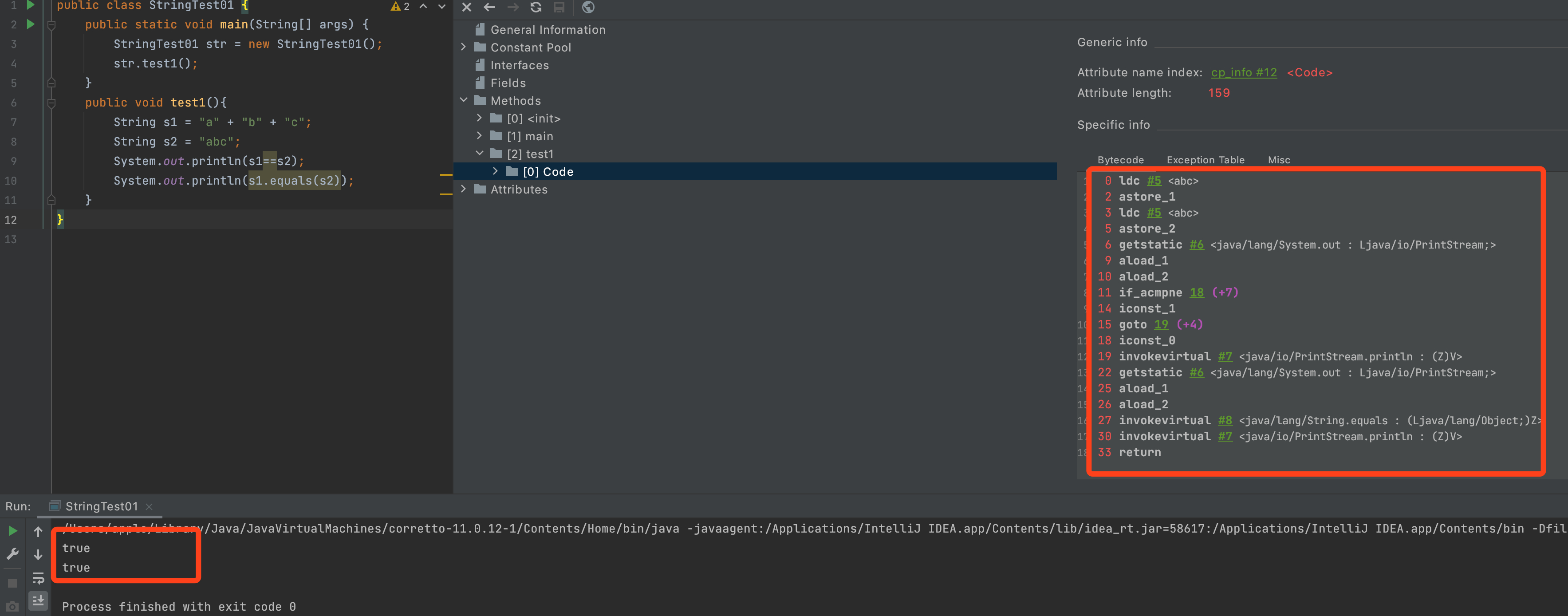1 String的基本特性
string:字符串,使用一对双引号表示
string s1 = "hello";
string s2 = new string("hello");
String 声明为final的,不可被继承
String 实现了Serializable接口:表示字符串是支持序列化,实现了Comparable接口:表示String可以比较大小
String在JDK8及以前内部定义了final char[] value用于存储字符串数据,JDK9时改为byte[]
2、String的内存分配
直接使用双引号声明出来的string对象会直接存储在常量池中
string s1 = "hello string";
如果不是使用双引号声明的string对象,可以使用string提供的intern()方法
Java 6及以前,字符串常量池存放在永久代
Java7 中将字符串常量池的位置调整到Java堆中
- 所有的字符串都保存在堆中,和其他普通对象一样,这样可以让你在进行调优引用是仅需要调整堆大小就可以
- 字符串常量池概念使用的比较多,但是这个改动使得我们有足够的理由让我们重写考虑在Java7使用string.intern()。
Java 8 元空间,字符串常量在堆
可以调整堆大小
-XX:MetaspaceSize=6m -XX:MaxMetaspaceSize=6m -Xms6m -Xmx6m
3、字符串拼接操作
- 常量与常量的拼接结果在常量池,原理是编译期优化
- 常量池中不会存放相同的内容常量
- 只要其中一个是变量,结果就在堆中,变量拼接的原理是stringBuilder
- 如果拼接的结果调用intern方法,则主动将常量池中还没有的字符串对象放入池中,并返回此对象

4、intern()的使用
官方注解:
/**
* Returns a canonical representation for the string object.
* <p>
* A pool of strings, initially empty, is maintained privately by the
* class {@code String}.
* <p>
* When the intern method is invoked, if the pool already contains a
* string equal to this {@code String} object as determined by
* the {@link #equals(Object)} method, then the string from the pool is
* returned. Otherwise, this {@code String} object is added to the
* pool and a reference to this {@code String} object is returned.
* <p>
* It follows that for any two strings {@code s} and {@code t},
* {@code s.intern() == t.intern()} is {@code true}
* if and only if {@code s.equals(t)} is {@code true}.
* <p>
* All literal strings and string-valued constant expressions are
* interned. String literals are defined in section 3.10.5 of the
* <cite>The Java™ Language Specification</cite>.
*
* @return a string that has the same contents as this string, but is
* guaranteed to be from a pool of unique strings.
* @jls 3.10.5 String Literals
*/
public native String intern();
面试题:new String(“ab”)会创建几个对象?
一个对象是new关键字在堆空间创建
另一个对象是:字符串常量池中的对象,可以通过字节码指令:ldc
Code:
stack=3, locals=2, args_size=1
0: new #2 // class java/lang/String //new在堆中
3: dup
4: ldc #3 // String ab //ab在常量池中
6: invokespecial #4 // Method java/lang/String."<init>":(Ljava/lang/String;)V //构造器初始化
9: astore_1 //得到对象赋给str,放入局部变量表
10: return
面试题:new String(“a”) + new String(“b”)会创建几个对象?在常量池不存在ab的
JDK6 以前有5个对象
JDK7 以后有4个对象
public class StringTest05 {
public static void main(String[] args) {
//String str = new String("ab");
//String s1 = "ab";
//执行这行代码字符串常量池不会存在"ab"
String str = new String("a") + new String("b");
str.intern();//在字符串常量池中生成"ab"(JDK7没有创建常量池ab而是创建一个指向堆空间对象,JDK6创建了一个对象ab)
String s1 = "ab";//s4变量记录的地址使用上一行的代码执行是在常量池生成的"ab"
System.out.println(s1==str);
}
}
更多收录于GitHub:https://github.com/metashops/GoFamily
GO学习路线:



























 被折叠的 条评论
为什么被折叠?
被折叠的 条评论
为什么被折叠?








